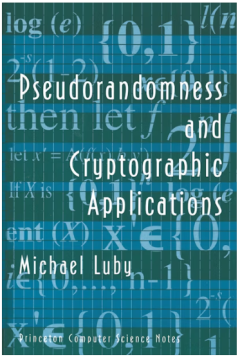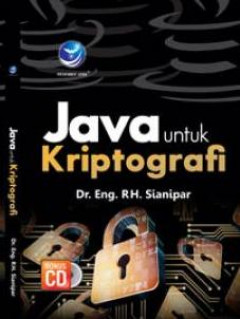Filter by

Understanding cryptography : a textbook for students and practitioners
Cryptography is now ubiquitous – moving beyond the traditional environments, such as government communications and banking systems, we see cryptographic techniques realized in Web browsers, e-mail programs, cell phones, manufacturing systems, embedded software, smart buildings, cars, and even medical implants. Today's designers need a comprehensive understanding of applied cryptography. Af…
- Edition
- first
- ISBN/ISSN
- 9783642041006
- Collation
- xviii, 372 p. : ill. ; 24 cm
- Series Title
- null
- Call Number
- 005.82 PAA u

Pseudorandomness and cryptographic applications
A pseudorandom generator is an easy-to-compute function that stretches a short random string into a much longer string that “looks” just like a random string to any efficient adversary. One immediate application of a pseudorandom generator is the construction of a private key cryptosystem that is secure against chosen plaintext attack. There do not seem to be natural examples of functi…
- Edition
- -
- ISBN/ISSN
- 9780691025469
- Collation
- xvi, 234 hal : 23 cm
- Series Title
- -
- Call Number
- 005.82 LUB p

Java untuk kriptografi
Daftar Isi Bab 1. JCA/JCE dan provider 1.1. Pengantar 1.2. Menginstal provider bouncy castle 1.3. Cara kerja provider 1.4. Memeriksa kapabilitas provider Bab 2. Kriptografi kunci simetris 2.1. Contoh pertama 2.2. Kelas utilitas dasar 2.3. Menggunakan AES 2.4. Pengganjalan cipher block simetris 2.5. Mode-mode cipher block simetris 2.6. Mode-mode cipher block simetris aliran 2.7.…
- Edition
- Ed. I
- ISBN/ISSN
- 9789792958836
- Collation
- vi, 218 hal.; ilus.; 23 cm + 1 CD
- Series Title
- --
- Call Number
- 005.82 SIA j

Prosiding- constructive side-channel analysis and secure design: 13th interna…
his book constitutes revised selected papers from the 13th International Workshop on Constructive Side-Channel Analysis and Secure Design, COSADE 2022, held in Leuven, Belgium, in April 2022. The 12 full papers presented in this volume were carefully reviewed and selected from 25 submissions. The papers cover the following subjects: implementation attacks, secure implementation, implementation …
- Edition
- -
- ISBN/ISSN
- 9783030997663
- Collation
- 279 hlm
- Series Title
- Lecture Notes in Computer Science Series
- Call Number
- PROS BAL p

Modern cryptography for cybersecurity professionals: learn how you can levera…
As a cybersecurity professional, discover how to implement cryptographic techniques to help your organization mitigate the risks of altered, disclosed, or stolen dataKey Features* Discover how cryptography is used to secure data in motion as well as at rest* Compare symmetric with asymmetric encryption and learn how a hash is used* Get to grips with different types of cryptographic solutions al…
- Edition
- -
- ISBN/ISSN
- 9781838647797
- Collation
- xiii, 269 hal : 23cm
- Series Title
- --
- Call Number
- 005.82 Boc m

Cryptography and cryptanalysis in java: creating and programming advanced alg…
Here is your in-depth guide to cryptography and cryptanalysis in Java. This book includes challenging cryptographic solutions that are implemented in Java 17 and Jakarta EE 10. It provides a robust introduction to Java 17's new features and updates, a roadmap for Jakarta EE 10 security mechanisms, a unique presentation of the "hot points" (advantages and disadvantages) from the Java Cryptograph…
- Edition
- -
- ISBN/ISSN
- 9781484281055
- Collation
- x, 227 hal :23 cm
- Series Title
- --
- Call Number
- 005.82 STE c

Asymmetric cryptography: primitives and protocols
Public key cryptography was introduced by Diffie and Hellman in 1976, and it was soon followed by concrete instantiations of public-key encryption and signatures; these led to an entirely new field of research with formal definitions and security models. Since then, impressive tools have been developed with seemingly magical properties, including those that exploit the rich structure of pairing…
- Edition
- -
- ISBN/ISSN
- 9781394188345
- Collation
- x, 448 hal : 23cm
- Series Title
- --
- Call Number
- 005.84 POI a

Algebraic cryptanalysis
Contents 1 Introduction: how to use this book Part I Cryptanalysis 2 The block cipher keeloq and algebraic attacks 3 The fixed-point attack 4 Iteratrd permutations 5 Stream ciphers Part II Linear systems mod 2 6 Some basic facts about linear algebra over GF (2) 7 The complexity of GF (2)-matrix operations 8 On the exponent of certain matrix operations 9 The method of fou…
- Edition
- --
- ISBN/ISSN
- 9780387887562
- Collation
- xxxiii, 356 hlm.; ilus.; 24 cm
- Series Title
- --
- Call Number
- 005.82 BRA a

Zero trust networks: building secure systems in untrusted networks
Perimeter defenses guarding your network aren’t as secure as you might think. Hosts behind the firewall have no defenses of their own, so when a host in the "trusted" zone is breached, access to your data center is not far behind. This practical book introduces you to the zero trust model, a method that treats all hosts as if they’re internet-facing, and considers the entire network to be c…
- Edition
- First edition
- ISBN/ISSN
- 9781491962190
- Collation
- xiv, 223 hlm : illus ; 24 cm
- Series Title
- --
- Call Number
- 005.82 GIL z

Pro cryptography and cryptanalysis with C++20: creating and programming advan…
Table of contents About the Authors About the Technical Reviewer Acknowledgments Part I. Foundations 1. Getting Started in Cryptography and Cryptanalysis 2. Cryptography Fundamentals 3. Mathematical Background and Its Applicability 4. Large Integer Arithmetic 5. Floating-Point Arithmetic 6. New Features in C++20 7. Secure Coding Guidelines 8. Cryptography Libraries in C/C++20 P…
- Edition
- -
- ISBN/ISSN
- 9781484265857
- Collation
- xvii, 469 hlm.; ilus.; 25,3 cm
- Series Title
- -
- Call Number
- 005.262 MIH p
 Computer Science, Information & General Works
Computer Science, Information & General Works  Philosophy & Psychology
Philosophy & Psychology  Religion
Religion  Social Sciences
Social Sciences  Language
Language  Pure Science
Pure Science  Applied Sciences
Applied Sciences  Art & Recreation
Art & Recreation  Literature
Literature  History & Geography
History & Geography